Every time I sit down with my InfoSec team, one thing becomes clear: managing governance, risk, and compliance feels like trying to hit a moving target. Regulations change, risks evolve, and no matter how robust the processes are, something always slips through the cracks. If you’re a compliance officer, risk manager, audit or even a CIO, you know exactly what I mean.
I’ve heard stories of teams buried under spreadsheets, scrambling to respond to audits, or wasting hours tracking down the latest policy updates. That’s probably why you’re here—looking for the best GRC software that can simplify all of that chaos and make your work more efficient.
As someone who writes extensively about cybersecurity and consults with experts in the field, I’ve had a front-row seat to the challenges professionals like you face. That’s why I’ve done the research to identify the 11 best governance, risk, and compliance (GRC) software for 2025.
In this article, I'll cover everything you need to know about these GRC tools—features, pros, cons, my personal review, and what other users have to say.
11 best GRC software for 2025: My Top Picks
- AuditBoard for automating audits and SOX compliance.
- Workiva for financial reporting and integrated compliance.
- Vanta for fast-growing companies that want continuous compliance monitoring with strong automation.
- Sprinto for cloud-first startups and mid-sized teams looking to get audit-ready quickly.
- Drata for tech-forward teams that want deep integrations and real-time compliance tracking.
- Scrut Automation for mid-sized companies automating compliance and security frameworks.
- Thoropass for companies that want guided audit support paired with software automation.
- Hyperproof for evidence collection automation and multi-framework compliance.
- Fusion Framework System for enterprises focused on business continuity and resilience planning.
- IBM Open Pages for scalable, AI-driven GRC solutions. (starts at $800 with $750/instance and $50/capacity unit)
- LogicGate Risk Cloud for highly customizable GRC solution.
*These are the top-rated products in the enterprise risk management category, according to G2 Grid Reports. Pricing is available on request for most of these tools, except for the one I have mentioned here.
Whether you’re trying to streamline audits, gain better insights into risk, or ensure your organization stays compliant, this guide will help you find the right fit for your needs.
11 best GRC software I recommend to simplify compliance
When I think about governance, risk, and compliance (GRC) software, I see it as a way to bring structure and clarity to the complex task of managing risks and compliance.
I’ve had countless conversations with my security, IT, and compliance teams, and one thing is clear: GRC really comes down to having processes in place to mitigate risk. But the right GRC tools go a step further—they make those processes easier and more efficient.
For example, automation is a huge quality-of-life improvement in GRC software. Instead of manually tracking when a regulatory compliance review is due, identifying gaps in risk assessments, or following up on audit tasks, a good GRC platform does the heavy lifting.
It sends timely reminders when actions need to be taken, like updating policies, conducting risk analyses and compliance audits, or submitting audit reports. It’s like having a guide that walks you through every step of a complex regulatory process, ensuring nothing gets overlooked—similar to how a software installation wizard simplifies setup. GRC covers governance at a high level, see a review of best operational risk management tools that dive deeper into daily business risks.
GRC software brings everything under one roof. It ensures policies are followed, risks are managed effectively, and compliance requirements are met—all without the chaos of spreadsheets or scattered tools. For my team, it’s not just about convenience; it provides a clear view of challenges and the confidence to address them efficiently.
How did I find and evaluate the best GRC platform?
I started with G2 grid reports of GRC platforms category and enterprise risk management category to create a shortlist of top-performing tools in 2025. Then, I turned to my InfoSec and compliance team to understand what features matter most to them in their day-to-day workflows.
Once I had a clearer picture, I explored these tools myself, diving into their capabilities and identifying what stood out—both the good and the bad. To add another layer of insight, I used AI to summarize reviews from other users, which gave me a better understanding of how these tools perform in real-world scenarios.
By combining all this research, I was able to find the five GRC tools that deliver the best balance of functionality, ease of use, and value.
One thing to note is that most of these GRC platforms only offer demos instead of full access unless you commit to a paid plan. Nonetheless, the demos show enough functionality to really understand their value and how they could fit our needs.
My criteria for the best GRC software
When I evaluated GRC tools, I didn’t just look at surface-level abilities. I took a deep dive into what matters most to InfoSec, compliance, and risk teams, ensuring my criteria were detailed and technical enough to meet their needs. Here’s what I prioritized:
- Ease of use with customization options: In my experience, no matter how advanced a tool is, it won’t deliver value if it’s hard to use. I looked for GRC tools that offered intuitive interfaces and minimal learning curves. At the same time, I wanted software that could adapt to different needs, such as customizable dashboards, workflows, and reporting templates. Flexibility is key because no two organizations have the exact same requirements.
- Automation that reduces manual workloads: One of the biggest pain points my compliance and risk teams shared with me is the time wasted on repetitive tasks. I paid close attention to tools that automate key processes, such as compliance tracking, risk assessment workflows, evidence collection, and external and internal audit task notifications. The ability to set triggers and receive real-time alerts when actions are due stood out as a must-have feature.
- Risk and compliance framework support: It was crucial that the tools support robust risk management capabilities—things like real-time risk identification, scoring models, risk heat maps, and dynamic mitigation tracking. On the compliance side, I checked for compatibility with major frameworks like ISO 27001, SOC 2, GDPR, HIPAA, and NIST. Tools that offer automated control mapping, gap analysis, and the ability to cross-reference frameworks were especially valuable.
- Integration with existing systems: I didn’t want tools that operate in isolation. For GRC to work well, it needs to connect with other systems such as ERP software like SAP and Oracle, CRM platforms, security tools like CrowdStrike and Splunk, identity management systems, and ticketing platforms like Jira. I looked for tools with open APIs and pre-built integrations that allowed smooth data sharing across platforms.
- Centralized policy and incident management: Policies are the backbone of compliance, and I evaluated tools that offer centralized storage, version control, automated distribution, and acknowledgment tracking for better policy management. Similarly, for incident management, I prioritized tools that provide real-time incident alerts, detailed root cause analysis, and integration with SIEMs for streamlined security workflows.
- Advanced reporting and visual analytics: My compliance and risk teams often need actionable insights. I focused on tools with powerful reporting capabilities that allow users to generate custom reports, track KPIs, and visualize data through dashboards, heat maps, and risk trends. Tools that offered granular filtering and exportable reports earned extra points in my evaluation.
- Scalability and mobility: As organizations grow, GRC software needs to scale with them. I evaluated how well the tools could handle increasing numbers of users, complex workflows, and growing data volumes. Mobile accessibility also mattered—teams need to manage risks and compliance on the go, and a tool without responsive design or mobile apps felt outdated.
- Data security and access control: Given how much sensitive information GRC tools handle, I was particularly strict about data security. I looked for role-based access controls, robust encryption, and compliance with global security standards like SOC 2 and ISO 27001. Without these, a tool simply doesn’t pass the bar.
- Audit and vendor risk management: Audits can be a nightmare without the right tools. I prioritized software that simplifies audit planning and execution, such as automated evidence requests, audit scheduling, and real-time tracking. Similarly, tools that support vendor risk assessments, contract monitoring, and dynamic risk scoring for third-party relationships earned higher marks.
- Support, documentation, and cost effectiveness: Finally, I needed tools that come with reliable support, clear documentation, and onboarding assistance. GRC is complex, and poor support can be a dealbreaker. At the same time, I compared pricing models to ensure the tools delivered value for money, especially for teams with tight budgets.
After evaluating 20+ GRC tools, I narrowed my list down to eleven. These tools stand out, offering the functionalities, efficiency, and reliability GRC professionals need.
The list below contains genuine user reviews from the best GRC software and ERM software categories. To be included in the ERM category, a solution must:
- Catalog, assess, and mitigate business-specific risks such as financial or health and safety.
- Provide tools to communicate risks to employees, customers, vendors, and suppliers.
- Create, maintain, and implement corporate policies and rules for internal and external use.
- Maintain an up-to-date repository of laws, regulations, and industry standards.
- Help users plan, implement, and track the performance of audit programs and tasks.
- Ensure business continuity management through incident management and risk mitigation.
- Deliver training and learning for compliance purposes, including certifications.
- Perform third-party, vendor, and supplier risk assessments and due diligence.
- Support multiple risk management methodologies, such as quantitative and qualitative.
- Gather and analyze environmental, social, and governance (ESG) data from various sources.
*This data was pulled from G2 in 2025. Some reviews may have been edited for clarity.
1. AuditBoard
AuditBoard is widely regarded as one of the top GRC tools, and its popularity among Fortune 500 companies is well-deserved. A consistent theme I’ve noticed in reviews is how user-friendly and intuitive the interface is, which makes the platform accessible to auditors, stakeholders, and compliance teams alike. G2 users often call out how well the platform is designed to meet the needs of its users, helping them navigate GRC processes with ease.
From what I’ve seen, one standout feature is the centralized approach to GRC management. G2 users often highlight how AuditBoard consolidates all risk-related information in one place, directly linking it to audit plans and integrating everything into a unified platform. This functionality seems to be a significant time-saver, reducing the complexity often associated with managing risk and compliance across various systems.
Another feature that receives a lot of praise in G2 reviews is the AuditBoard Business Intelligence (ABI) dashboard. Reviewers appreciate that the dashboard not only looks visually appealing but also provides real-time, actionable insights into risk management, audit trails, and control testing. This functionality makes it easier and more efficient for teams to manage complex GRC tasks, and it's a feature that many users seem to rely on heavily.
Additionally, AuditBoard’s AI-powered functionalities are frequently highlighted. G2 users often mention how the platform’s AI helps with tasks such as generating vendor questionnaires, creating new controls, and summarizing audit reports. This automation is seen as a major time-saver, allowing teams to focus on higher-level tasks rather than getting bogged down in manual document creation.
I’ve also come across a lot of positive feedback regarding AuditBoard's integration capabilities. Many users highlight how the platform easily integrates with existing workflows, connecting with tools like CRM or ERP systems, HR software, and identity management tools. This seamless interoperability reduces the need for manual data transfers and helps teams work more cohesively across departments.
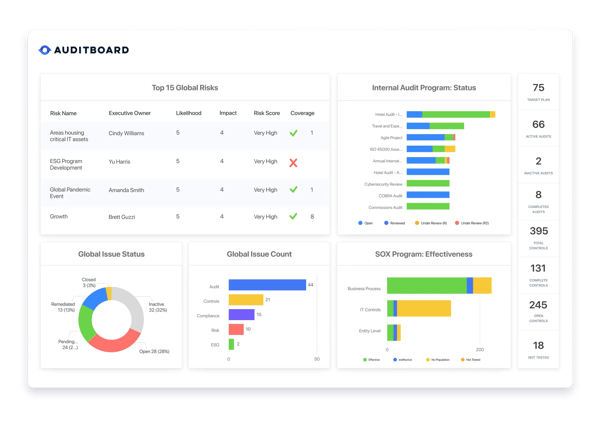
However, some concerns are mentioned in G2 reviews. One common point is that setting up the ABI dashboards can be time-consuming. While the customization options are robust, some users note that the process can take longer than expected, especially for teams that are pressed for time or resources.
Another issue users mention is the frequency of updates. While updates are generally appreciated, some reviewers have pointed out that new features are sometimes automatically enabled without prior notice, leading to confusion or unexpected changes to their dashboards. I’ve seen several users express frustration with this lack of communication around updates.
Overall, AuditBoard is widely praised for its ability to simplify and enhance GRC processes. Based on G2 user feedback, its combination of centralization, real-time insights, AI-powered automation, and seamless integrations make it a strong choice for organizations looking to streamline their risk and audit management. However, users do point out that improvements in communication around updates and a more efficient dashboard setup process could enhance the experience further.
What I like about AuditBoard:
- One standout capability, according to users, is the intuitive interface. Many note that it feels purpose-built for professionals like auditors, compliance teams, and risk managers, making complex tasks easier to manage.
- I’ve also noticed a strong appreciation for how the platform centralizes risk, control, and audit management. Reviewers often highlight that it reduces the need for multiple tools and keeps everything connected and organized.
What G2 users like about AuditBoard:
"Audit Board offers almost everything you need to manage the Audit world. The various models allow you to build the solution and tailor it to your needs. What amazed me the most was the Academy program and the community that supports you before and after your implementation Project.
After a few months of use, the whole company already feels the impact, especially on the reactiveness towards issues and Action Plans! We use the Audit board daily, both for fieldwork and Audit Management. After six months in the system, we are still Improving our process thanks to the features of the system and the constant updates and new functionalities offered."
- AuditBoard Review, Giacomo S, International Internal Auditor.
What I dislike about AuditBoard:
- I’ve read multiple reviewers mention that setting up dashboards can be time-consuming. While the customization is powerful, it’s not always straightforward—especially when handling more complex setups.
- Looking at the broader review trends, there’s some frustration around unexpected updates. When new features are enabled automatically, users can get confused, suggesting that clearer communication could make the experience smoother.
What G2 users dislike about AuditBoard:
"The permissions matrix is a little complex from an administrator standpoint - need to make sure you spend the time understanding teams versus roles and how to customize them accordingly. This goes back to making the most of your implementation phase.
Also, there is almost always a new feature being released or enhanced. At times (like when enhancements just show up rather than needing to be enabled), features can confuse users or cause them to use functions when not desired. This should be minimized by having an active administrator."
- AuditBoard Review, Kylie G, Senior Auditor and Data Analyst.
2. Workiva
Workiva is widely praised for its ability to streamline financial reporting and compliance processes. Users often highlight its strengths in integrating data from various sources, such as general ledger software, ESG reporting tools, and HR systems.
One feature that stands out in many reviews is the ability to link data across multiple reports and documents, which is particularly valuable for tasks like Sarbanes-Oxley (SOX) compliance and SEC filings. Users consistently emphasize how Workiva automatically updates linked data in real time, reducing the risk of inconsistencies across documents and ensuring accuracy during critical reporting periods.
A common theme I’ve noticed in G2 reviews is how Workiva facilitates collaboration. Many users appreciate how multiple teams—such as finance, legal, IT, and risk management—can work on the same document simultaneously, without worrying about version control. This collaborative functionality is often described as a huge time-saver, making the process more transparent and efficient.

However, there are some drawbacks mentioned in G2 reviews. Workiva’s occasional slow performance is a common concern, with users noting that it can freeze or slow down when multiple tabs are open or when handling large volumes of data. This issue tends to be particularly frustrating during critical moments, when efficiency is crucial.
Additionally, document editing and formatting are areas where users express some dissatisfaction. Multiple G2 reviewers mention that documents imported from Word into Workiva can experience formatting issues, such as misaligned margins or unexpected page breaks. These issues can make document editing more cumbersome, adding time to an otherwise streamlined process.
Despite these drawbacks, Workiva is still highly regarded by G2 reviewers as one of the best solutions for financial and ESG reporting. Many users recommend it for companies looking to streamline their financial reporting and compliance processes, reduce the stress of managing large-scale reporting, and ensure consistency and accuracy across linked documents.
What I like about Workiva:
- One standout capability, according to G2 users, is automatic data linking—when a figure is updated in one spot, it syncs across documents, saving time and ensuring accuracy.
- I’ve seen multiple reviewers highlight real-time collaboration as a major plus, helping teams work simultaneously without version control issues.
What G2 users like about Workiva:
"Workiva has a very intuitive financial reporting platform. I can easily make formatting changes and ensure my document is SEC-compliant. Workiva also allows me to integrate data from various sources, automating data linking across reports and improving accuracy.
Workiva also allows multiple users to work simultaneously on documents, ensuring real-time updates and reducing version control issues. I can easily track my work through easily generated redlines.
Workiva also provides great customer support. For any document or filing issue, I can reach a Workiva specialist within minutes."
- Workiva Review, Bo G, Director of SEC Reporting and Accounting.
What I dislike about Workiva:
- I’ve come across G2 user feedback around performance issues, with users mentioning slowdowns or freezing when handling large data sets or multiple tabs.
- Based on my review of G2 feedback, editing and formatting limitations are a common pain point, often leading to extra time spent fine-tuning documents.
What G2 users dislike about Workiva:
"I feel like sometimes my brain goes faster than how long it takes to switch between a Workiva document and a Workiva spreadsheet. Sometimes, when I copy a source link and paste it into the Workiva document, it takes a while, and when I have numerous things to copy, it just ends up messing with my speed."
- Workiva Review, Daisy Y, Small Business.
Focused on financial crime prevention? Strengthen your compliance stack with our picks for the top anti-money laundering tools covering KYC, transaction monitoring, and automated reporting.
3. Vanta
Vanta has become one of the most recognized names in the GRC space, and from what I’ve seen, it absolutely earns that reputation. I’ve noticed it’s especially well known for its automation capabilities and clean, user-friendly interface, which makes navigating compliance work a lot less intimidating.
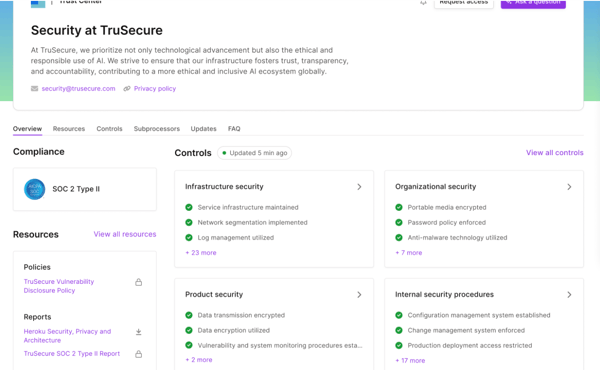
With over 10,000 organizations using it, including big names like Atlassian and Quora, it’s clear I’m not the only one who sees the value.
What really sets Vanta apart for me is how effortlessly it streamlines the compliance process across more than 35 frameworks, including SOC 2, ISO 27001, and HIPAA. It turns something as complex as compliance into a much more manageable, even intuitive, experience.
One thing I found especially valuable is the ability to continuously monitor our systems through over 1,200 automated tests, along with access to 370+ integrations that help simplify compliance across our tech stack.
That said, some reviewers on G2 did mention that not all integrations offer the same level of depth or flexibility even though the overall integration coverage is strong.
I also came across feedback from businesses noting that Vanta can be on the pricier side, especially for teams with more modest budgets or simpler compliance needs.
Even with those critiques in mind, what I kept seeing and honestly agree with is that Vanta takes a huge chunk of the manual work out of staying compliant. It’s one of those tools that just makes the whole process feel more manageable and less like a never-ending checklist.
So, Vanta is definitely worth considering, in my opinion. I’d say it’s especially great for growing companies that want to build out their security programs without hiring a whole compliance team.
What I like about Vanta:
- Based on my research, what really stood out to me is how Vanta automates over 1,200 checks behind the scenes. It’s designed to take the heavy lifting out of staying compliant, which a lot of users seem to appreciate.
- I also found it impressive that Vanta supports 35+ security frameworks and lets you cross-map controls between them. That kind of flexibility can really simplify things for teams managing multiple compliance requirements.
What G2 users like about Vanta:
"Vanta makes everything easier on our compliance process. We use it mostly to make sure our policies are applied correctly, and ensure all processes we have in the company align, are compliant, and secure.
Removing a lot of manual work and having everything integrated in one place is a big win for our team. Also, whenever I've had to reach out to customer support, they're quick to respond and helpful."
- Vanta Review, Paulina S, SRE.
What I dislike about Vanta:
- From what I’ve seen in G2 reviews, some users ran into limitations with certain integrations; not all of them offer the same depth or customization.
- I also noticed several users mentioning that the pricing felt a bit steep, which could be a barrier if you’re working with a tighter budget.
What G2 users dislike about Vanta:
"Some features aren't as 'user-friendly' as they could be, though this continues to be enhanced over time with customer feedback being taken into account. While we've had some issues with a certain 3rd party integration, Vanta has continued to make themselves and their engineers available to help resolve (even though the issue lies with the other 3rd party and not Vanta). I'm sure some of the "kinks" I refer to will be worked out over time with future sprints and continued customer feedback."
- Vanta Review, Brooke Lynne B, Compliance Manager.
4. Sprinto
From everything I’ve read and researched, Sprinto positions itself as a modern GRC tool built specifically for cloud-native companies, and that focus really comes through.
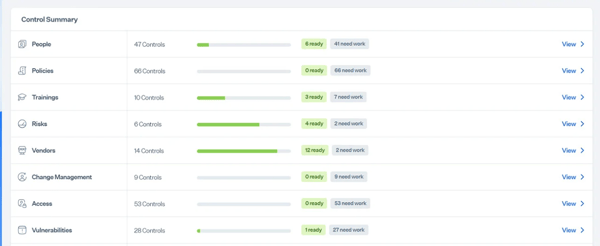
What stood out to me most in user reviews is how quickly teams are able to get up and running; several users mentioned completing setup and being audit-ready in just a few weeks, thanks to Sprinto’s built-in playbooks and automated evidence collection.
The platform seems to do a great job of mapping out compliance tasks clearly, assigning responsibilities, and nudging teams toward completion, which takes a lot of the guesswork out of preparing for audits like SOC 2 or ISO 27001.
I also found it impressive how Sprinto automatically monitors systems and logs evidence in real-time. This not only reduces manual tracking but also gives teams real-time visibility into their compliance posture.
On top of that, the customer support experience seems to be a real differentiator. Multiple users specifically called out how responsive and hands-on the support team is, whether it’s customizing controls or clarifying framework requirements, Sprinto’s team seems to act more like a partner than a vendor.
That said, there are a couple of things I’d flag based on user reviews. Some teams mentioned that a few integrations were tricky to set up during onboarding, and in certain cases, specific tools weren’t available out of the box. It seems like the integration experience can vary a bit depending on your stack.
I also came across a handful of reviews that mentioned minor bugs or occasional slow loading times. These weren’t dealbreakers for most users and were often resolved quickly, but they’re still worth keeping in mind if consistency and performance are a top priority for your team.
If your team is navigating multiple compliance frameworks and wants a tool that guides you through the process without overwhelming you, Sprinto is a solid bet.
From what I’ve seen, it’s especially well-suited for fast-growing cloud-first companies that need structure, automation, and hands-on support to hit compliance goals confidently.
What I like about Sprinto:
- One thing I found really valuable, based on user reviews, is how quickly teams are able to go from onboarding to being audit-ready. The built-in playbooks and automated control mapping seem to save a lot of time.
- What stood out to me in several reviews is how clearly Sprinto breaks down compliance tasks. It actually helps assign responsibilities, track progress, and keep the whole team aligned throughout the audit process. That kind of structure can make a big difference when you're juggling multiple frameworks.
What G2 users like about Sprinto:
"Our experiences with Sprinto have been extremely positive throughout the last year. One of the most noticeable advantages of implementing Sprinto has been how successfully it has helped us manage our SOC2 and VAPT compliance duties. We felt at ease using the platform because the Sprinto support staff was always helpful and responsive whenever we had any issues or questions.
This efficiency was notably useful in resolving compliance issues that were causing numerous firm agreements to be delayed. In short, Sprinto was critical in securing the success of these deals by negotiating compliance issues.
It's never been easier to understand our company's policies. Furthermore, the security training sessions are simple, and reporting our work gadgets is a breeze. Sprinto appears to have simplified all of the complicated aspects of compliance. It's such a relief to have this in our toolbox!"
- Sprinto Review, Harika K, Software Engineer.
What I dislike about Sprinto:
- Some reviewers mentioned that setting up certain integrations wasn’t always seamless, especially during onboarding, and a few key tools weren’t supported right away.
- I also noticed feedback about occasional bugs or slow loading times—nothing major, but something to note.
What G2 users dislike about Sprinto:
"There have been glitches with the updates and enhancements. Currently dealing with the application collecting data, but not being able to automatically post. The testing process must be enhanced with SaaS SaaS-related solution. We are using the standard Windows OS, so no related complications. Customer Support needs to be more proactive in resolving these problems."
- Sprinto Review, Naresh L, Senior Partner and Compliance Officer
5. Drata
I’ve come across Drata a lot in discussion forums and heard plenty about it from colleagues. What really caught my attention is how it makes security compliance, like SOC 2, ISO 27001, and HIPAA, way less of a headache.
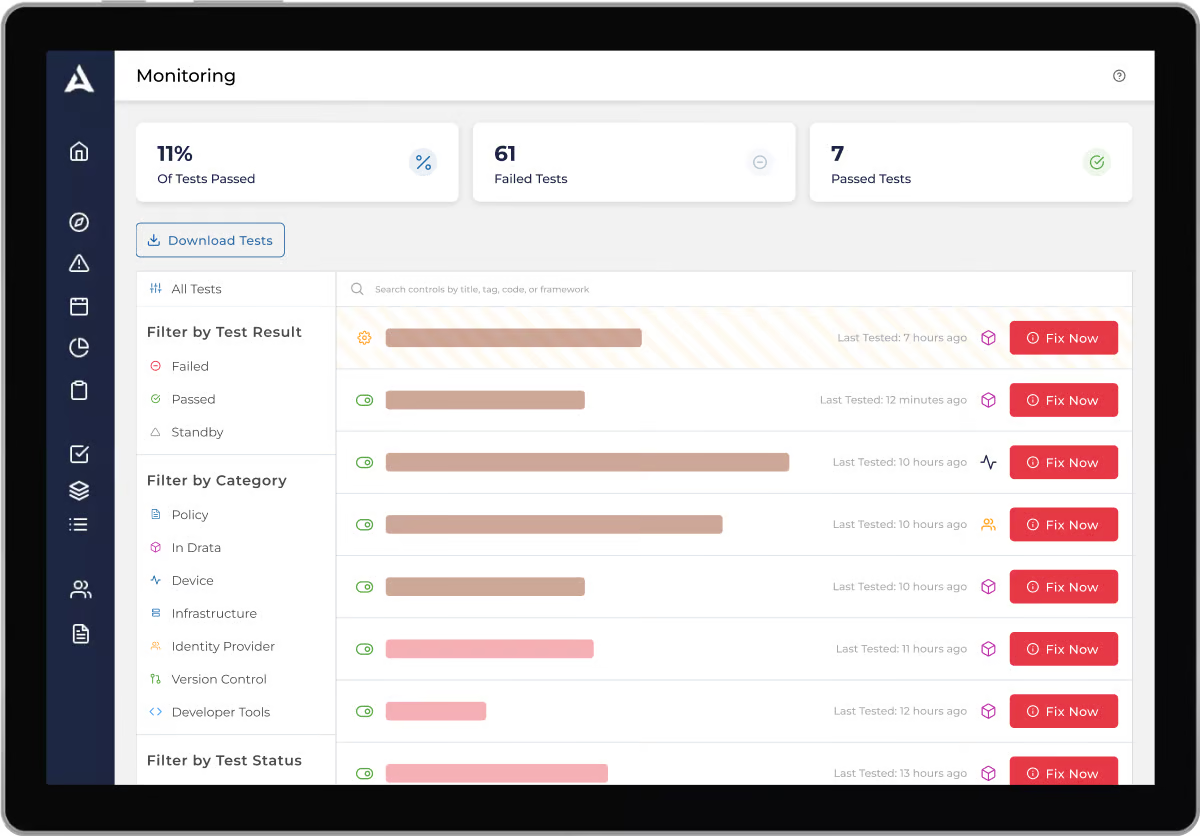
What really impressed me is how well it balances automation with structure. Drata has all the features you expect in a GRC tool. It connects directly to your MDMs to pull device details, links up with your HRIS or IAM to grab user data, and even connects to your cloud infrastructure to help secure configurations. You can store reports and documents right on the platform, and it makes evidence updates super easy with reminders.
I saw users consistently mentioning how this live connection reduces the manual overhead of compliance and keeps them confident they’re always audit-ready, not just during crunch time.
Another feature I found noteworthy is how Drata supports version control, and mass management of controls. These small but powerful details show up again and again in reviews as major time-savers.
I also appreciated how several users highlighted the value of Drata’s Trust Center, which helps communicate your security posture transparently with customers and stakeholders. Plus, their policy templates and workflows make it easier to get buy-in from across the company, even from teams that don’t normally think about compliance.
But, I did see some minor snags. A few have pointed out that some integration points could be expanded or improved to allow for even smoother operation.
Also, while the platform’s dashboard is generally intuitive, some users have mentioned that certain areas could benefit from better user interface feedback. For example, when something breaks or falls out of compliance, more visual indicators or clearer notifications could help users quickly identify and address these issues.
From what I’ve seen, Drata seems like a perfect fit for mid-sized companies or teams that are growing quickly and need an automated way to stay on top of compliance. If you’re scaling fast and want to keep things running smoothly without needing a whole compliance department, it’s definitely worth considering.
What I like about Drata:
- I really appreciate how Drata automates much of the compliance process. It connects with tools like AWS, Okta, and GitHub, making it easier to stay audit-ready without having to manually collect evidence.
- The Trust Center is a big plus for me. It makes sharing your compliance status with customers a lot more transparent and straightforward. Plus, the policy templates and control guidance help streamline the whole process.
What G2 users like about Drata:
"Drata has taken a complex, often burdensome process like SOC 2 compliance and made it manageable and clear. The continuous control monitoring gives our team real-time visibility into our compliance posture, which means we’re not scrambling last minute or relying on guesswork. Integrations with our existing tools were smooth, and the platform's automation features cut down on time spent chasing documentation. Their support team has also been highly responsive and knowledgeable, which matters when you're dealing with audits and deadlines.."
- Drata Review, Jorge A, Director of IT.
What I dislike about Drata:
- While the platform is generally intuitive, some users mentioned that it could use clearer feedback on the dashboard, especially when something falls out of compliance.
- A few reviews pointed out that certain integrations could be smoother. While Drata connects with many tools, some users found that the setup or syncing with specific systems could take a bit more work to get right or lacking.
What G2 users dislike about Drata:
"I would wish for more native integrations with third-party vendors, since this really where such a tool shines, and more support for self-hosted versions, since we are big proponents of self-hosting."
- Drata Review, Jean-Francois P, Architect, Infrastructure Operations and Security
6. Scrut Automation
Scrut Automation is frequently highlighted for its ability to simplify compliance processes, making them feel more manageable rather than like an endless checklist. Many users express appreciation for how well it balances automation with usability, which sets it apart from more enterprise-heavy GRC tools that often come with steep learning curves and months of onboarding.
One feature that I see getting a lot of praise is Scrut’s effectiveness in managing multiple compliance frameworks. G2 users often mention how Scrut centralizes everything in one place, making it easier to navigate overlapping requirements such as ISO 27001, HIPAA, SOC 2, and cyber risk management. Users consistently note that the tool’s automation, especially in evidence collection and audit workflows, significantly streamlines compliance management.
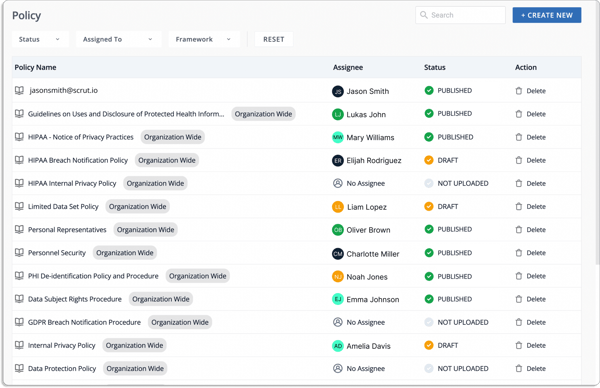
From what I’ve seen, Scrut’s automation features are a key strength. Many reviewers highlight how these features improve efficiency and reduce manual workloads. However, there’s noticeable feedback regarding the initial setup process, with several users mentioning that configuring Scrut can be time-consuming. While this is not uncommon for GRC platforms, it’s something to consider if you’re seeking a more plug-and-play solution.
Another point that comes up in G2 reviews is Scrut’s agent software, which automates evidence collection. While the feature is generally appreciated, some users have mentioned that it doesn’t always perform as expected, indicating potential room for improvement.
Despite these challenges, Scrut Automation is highly recommended, especially for industries like cybersecurity, health tech, and fintech, where compliance is a constantly evolving challenge. I’ve seen multiple G2 reviewers suggest it as an ideal platform for mid-sized companies that need a scalable, audit-friendly solution to manage policies, risks, and security frameworks in a single tool.
What I like about Scrut Automation:
- One feature that I see getting a lot of praise is framework automation—G2 users highlight how Scrut simplifies managing ISO 27001, HIPAA, and SOC 2 by centralizing documentation and automating audit tasks.
- A consistent theme in reviews is appreciation for guided compliance workflows, which help teams go beyond box-checking and genuinely strengthen their security posture.
What G2 users like about Scrut Automation:
"Scrut Automation has significantly streamlined our compliance and security processes. The platform's user-friendly interface, comprehensive dashboard, and intuitive automation features make managing frameworks like ISO 27001, SOC 2, and GDPR effortless.
I particularly appreciate the automated evidence collection, which saves hours of manual work and reduces the risk of human error. The integrations with our existing tools (like AWS, Slack, and Jira) were seamless, ensuring all our data sources are covered."
- Scrut Automation Review, Karan A, Head of Domain Operations.
What I dislike about Scrut Automation:
- From what I observed, once everything is in place, Scrut runs smoothly, but getting there takes more time and effort. So, be prepared to spend time setting up controls, mapping frameworks, and configuring workflows before it really starts paying off.
- I've realized that while the Scrut agent is useful for scanning and monitoring security posture in endpoint devices, it could be improved for better performance. There are occasional sync issues
What G2 users dislike about Scrut Automation:
"While Scrut offers customizable controls, some organizations with highly complex requirements might find the pre-built template limiting. customization beyond a certain level requires manual intervention or workarounds. Scrut automation is very effective, but the one thing is that it provides many features, so for new users, it is overwhelming without sufficient training."
- Scrut Automation Review, Gautam M, DevOps Engineer.
7. Thoropass
I first came across Thoropass (formerly Laika) when I saw it in the G2 Grid report and decided to research further. With its focus on automating much of the process, it’s designed to make staying compliant easier for teams that may not have a dedicated compliance department.
What sets it apart from my understanding isn’t just the ability to manage multiple frameworks like SOC 2, ISO 27001, HIPAA, and GDPR, but how it combines automation with real, hands-on support.
Thoropass pairs you with a compliance expert and gives you access to a team that actually helps you prepare for and complete audits. That human layer of support feels more personalized than some of the larger platforms out there, and several users mentioned that this was a huge reason they stuck with Thoropass.
That said, the platform isn’t perfect. I observed some users saying the UI can feel cluttered, especially when navigating more detailed tasks or compliance workflows. While the dashboard gives a good high-level overview, feedback around alerts or next steps could be more intuitive when something goes out of compliance.
I also saw a few notes about limited customization and a desire for deeper integrations with certain tools.
But on the whole, if you're looking for a compliance platform that covers all the bases, from daily readiness to audit execution, Thoropass is worth a look.
What I like about Thoropass:
- Based on my research, I really like that Thoropass doesn’t just give you software; it actually pairs you with a compliance expert who helps guide you through the audit process, which feels like a big differentiator.
- I also found it useful that the platform integrates with key systems like cloud infrastructure, HR tools, and MDMs to automatically collect evidence and keep you continuously audit-ready.
What G2 users like about Thoropass:
"I appreciated having the Thoropass portal as a centralized repository to store all of our documentation. It also served as a guide to ensure we completed everything necessary in a timely manner. Having a personal contact to meet with regularly was also very helpful. RJ and Ritu were always available to address any questions we had along the way."
- Thoropass Review, Mary R, Chief Operating Officer.
What I dislike about Thoropass:
- Some users mentioned that the UI can feel a bit clunky or overwhelming at times, especially when navigating more detailed workflows.
- I also noticed a few reviewers calling out limited customization options and a desire for broader integrations, which could be a drawback for teams with more complex setups.
What G2 users dislike about Thoropass:
"There have been a few small buggy issues in the platform's UI. Entering notes for evidence was touchy as well as updating documents. As we get through more audits, having an easy reference to our past evidence notes, etc. would be greatly beneficial and this has not been possible. The upside is that our Customer Success Manager has been great at communicating these issues and they have either been addressed or are considered for future product updates."
- Thoropass Review, Andrew L, Chief Technology Officer.
Did you know if your business runs a lab, it's better to ISO 17025 accredition? Learn from our expert on how to comply with the regulation.
8. Hyperproof
Hyperproof stands out as a popular GRC tool, mainly due to its simplicity and its ability to manage a wide range of risk and compliance processes efficiently. Users frequently mention how its straightforward design makes it a favorable choice for those navigating GRC tasks, even if they aren't deeply familiar with the field.
One feature that I see getting a lot of praise is Hyperproof's clean and intuitive interface. Many users highlight how easy it is to navigate, even for non-experts in GRC processes. The simple yet functional design is consistently recognized for making the tool accessible without overwhelming users with complex features.
According to feedback I gathered from G2 users, Hyperproof’s 150+ pre-built templates for various compliance frameworks, like NIST, SOC 2, GDPR, HIPAA, PCI DSS, and SOX, are widely appreciated. This extensive library allows companies to quickly get started with the necessary frameworks. Users also appreciate the option to create custom templates, offering flexibility based on specific needs.
A commonly appreciated element is Hyperproof’s automation for evidence gathering. From what I’ve seen, G2 users are particularly impressed by how the tool automates the evidence collection process, linking evidence directly to controls and updating it automatically. This significantly reduces manual tracking and ensures smoother audits, especially under time pressure. Many reviewers note that the de-duplication of overlapping controls between different frameworks is a standout feature that enhances its effectiveness.
Across multiple reviews, Hyperproof's vendor management module is another feature that draws positive attention. G2 users often call out how it centralizes vendor data and makes it simple to monitor and manage risks. This centralization streamlines audit processes, allowing users to pull up relevant vendor data quickly, which saves time during audits and ensures nothing is overlooked.
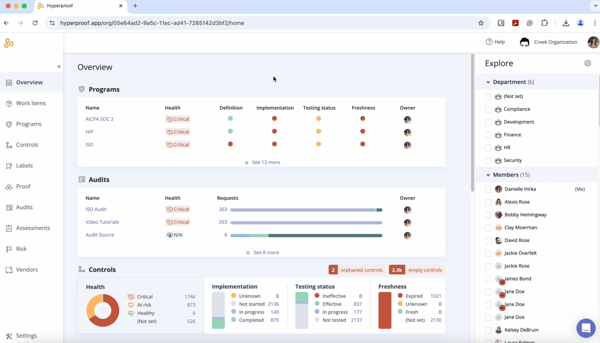
However, I’ve noticed that Hyperproof’s terminology can be a point of confusion for users familiar with other GRC tools. From what I’ve gathered, this difference in terminology introduces a learning curve for some users, although most agree it’s not a significant hurdle once they get used to it.
Another challenge I’ve come across in G2 reviews is the limitations in reporting customization. Many users express frustration with the lack of control over templates and data visualization options. While Hyperproof does a great job covering the basics, users expect more flexibility in customizing reports to suit specific needs.
Finally, looking at the broader review trends, I can see deployment and integration setup being a recurring concern. Although the tool is praised for its ease of use, some users mention that the effort required to deploy Hyperproof into production, particularly when integrating with existing systems to automate compliance functions, can be quite intensive. This could be a challenge for companies with more complex compliance programs.
Despite these limitations, Hyperproof continues to receive positive feedback overall, especially for organizations aiming to automate their GRC workflows. The consistency and time-saving benefits it provides are often highlighted as major advantages.
What I like about Hyperproof:
- One standout capability, according to G2 users, is automated evidence collection, which streamlines audit prep by linking and updating evidence directly to controls.
- I’ve noticed users frequently appreciate the pre-built compliance templates, which help manage overlapping standards like ISO, PCI DSS, and NIST with less effort.
What G2 users like about Hyperproof:
"It is user-friendly and easy to navigate. The dashboard is very helpful for a quick look and checking your company's compliance status. The features are good. Hyperproof is continuously improving, and they do updates regularly. Workshops are good, especially if they have new features coming in.
Hyperproof support is awesome; you'll get a swift response if you have a concern, and they will provide a temporary solution while checking on your concern. They will update if there's any development.
Our company has been using Hyperproof for almost three years now, and it has really changed the way we manage our compliance. It makes my job much easier. Hyperproof listens to its customers' feedback, which I believe is why it has improved its product so significantly. "
- Hyperproof Review, Apple A, Senior Compliance Analyst.
What I dislike about Hyperproof:
- From my observation, the reporting features leave much to be desired. While Hyperproof provides basic reporting capabilities, the customization options are limited.
- While the platform is easy to use, I feel getting Hyperproof into production takes effort. The deployment process required significant time and resources, which could be a challenge for smaller teams.
What G2 users dislike about Hyperproof:
"The dashboard lacks customization options, and the internal reporting feature falls short of expectations, as it is also non-customizable. Hyperproof’s suggested solution is to use Snowflake integration to extract data and generate reports. Additionally, a customizable, template-based questionnaire for assessments is not available."
- Hyperproof Review, Satish S, Senior Cloud Compliance Lead.
9. Fusion Framework System
Fusion Framework System takes a straightforward, no-nonsense approach to risk and resilience management, which, according to G2 user feedback, makes it a preferred choice for many organizations.
A consistent theme in G2 reviews is that Fusion’s focused approach to risk management is one of its biggest strengths. Unlike some GRC tools that attempt to cover everything, Fusion keeps things streamlined, focusing on what truly matters: making risks visible, automating critical processes, and enabling teams to respond effectively in times of crisis.
One feature that I see getting a lot of praise from G2 reviewers is Fusion’s ability to consolidate multiple functions into a single, unified platform. Users often highlight how the platform integrates business continuity planning, incident response, and third-party risk management, providing a holistic framework for managing risk. This consolidation is highly valued by teams seeking to keep things organized and efficient.
From what I’ve seen in G2 reviews, risk response automation stands out as one of Fusion’s strongest capabilities. G2 users often mention that the platform does more than just track risks—it connects risk assessments to business continuity and incident response plans, which makes it particularly valuable for organizations focused on building resilience rather than simply ensuring compliance.
Another aspect G2 users frequently call out is Fusion’s customizable dashboards. Many reviewers express appreciation for how they can tailor their dashboards to display the exact information they need. This customization significantly enhances how teams track risks and compliance tasks, according to user feedback. Additionally, real-time reporting is a commonly appreciated feature, allowing teams to stay updated on the status of risks and mitigation efforts.
However, I’ve noticed some recurring feedback regarding performance issues. Several users mention that the platform can experience occasional slowness, especially when handling large datasets or generating complex risk reports. There’s also feedback from G2 users indicating that multiple simultaneous logins can cause the platform to lag. While this isn’t seen as a dealbreaker, users report that it can be frustrating, particularly when needing to pull time-sensitive information for audits or other critical tasks.
I’ve read multiple reviewers mention that setup can be time-consuming. While Fusion is praised for its flexibility, users highlight that this flexibility comes with a trade-off—it requires a significant amount of configuration to get the most out of the platform. Some users mention that the initial learning curve can be steep, especially if a team doesn’t have dedicated resources for the setup process. For teams with limited capacity, this can make the onboarding process feel overwhelming.
In conclusion, based on G2 user feedback, Fusion Framework System is highly regarded for its effective and streamlined approach to risk and resilience management. While it requires an investment of time and resources to set up and configure, its powerful features and automation capabilities make it an invaluable tool for organizations that are willing to commit to its implementation.
What I like about Fusion Framework System:
- Something G2 reviewers seem to really appreciate is the customizable dashboard, which helps surface key data—like risks or compliance tasks—without the need to navigate multiple menus.
- I’ve seen multiple users highlight the value of centralized risk data, noting how it simplifies tracking and decision-making by bringing everything into one place.
What G2 users like about Fusion Framework System:
"Risk management is one of the most impressive features of the Fusion Framework System, and I find it exceptional. By integrating it with our systems, it gives us the ability to analyze risk data in a centralized fashion. Dashboards providing real-time data with possible layouts are essential for decision-making in the company. Certain features, such as managing incidents and tracking regulatory compliance, have also made processes simpler and improved our overall risk management strategy."
- Fusion Framework System Review, Martin B, Director of Risk Management.
What I dislike about Fusion Framework System:
- I’ve noticed that G2 users often call out performance slowdowns, particularly during high usage or when generating reports, which can interrupt workflow.
- Across multiple reviews, users mention a steep learning curve, pointing to the time and effort needed to configure the platform due to its flexibility.
What G2 users dislike about Fusion Framework System:
"Getting started may seem to be a big load because there is so much one could do with it. Some more transparent steps or additional help at the very beginning would be helpful for sure. And sometimes, it becomes a bit slow when we are working with larger volumes of data. This becomes kind of irritating. It is necessary to speed up this process. This would be really helpful."
- Fusion Framework System Review, Harold P, Risk Management Specialist.
10. IBM OpenPages
IBM OpenPages is frequently praised for its scalability and adaptability, which reflects IBM’s deep expertise in developing solutions for complex business challenges. Users often highlight its ability to scale from small teams to thousands of users, making it a strong choice for large enterprises that need to manage risks across multiple domains, both in front-office and back-office functions.
A standout feature in many reviews is OpenPages' modular nature. Users consistently appreciate how it allows them to deploy domain-targeted modules for specific needs, such as regulatory compliance, IT risks, and operational risks. This flexibility is commonly noted as a key reason for its appeal in diverse industries.
From what I’ve seen, AI-driven capabilities are another major highlight in G2 reviews. Many users are impressed with how the platform automates workflows using simple drag-and-drop functionality, and how it leverages predictive analytics through IBM Cognos to streamline audit and compliance tasks. One specific use case that comes up frequently is the integration of AI for incident reporting. Users appreciate that it doesn’t just flag risks but uses relevant classifications to enhance the accuracy and efficiency of reporting, making the process more effective.
A recurring theme in reviews is OpenPages' flexibility in deployment options. Many users emphasize how it can be deployed behind a firewall or in the cloud, adapting easily to different infrastructure needs. This flexibility is particularly valuable for organizations with strict IT or data governance policies., as it allows them to maintain control over their environment.
One feature that I see getting a lot of praise is the platform’s integration capabilities. G2 reviewers often mention how well OpenPages integrates with third-party systems. Through IBM App Connect and REST APIs, users can easily connect OpenPages to other critical tools in their tech stack without facing significant integration challenges.
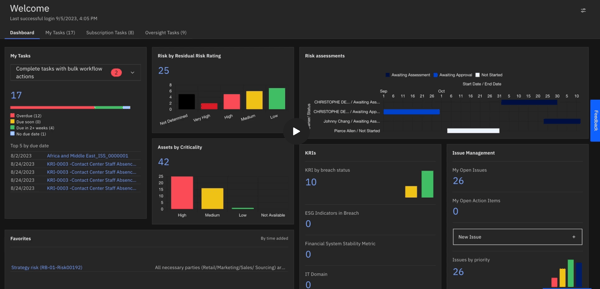
However, based on my review of G2 feedback, the onboarding process is a common pain point. Many users mention that while OpenPages is a powerful tool, it can feel overwhelming to implement, especially for teams that have no prior experience with similar GRC solutions. The extensive customization options, although valuable, are noted to require considerable time and resources during setup, which can be a barrier for some teams.
Additionally, the cost of IBM OpenPages is frequently cited as a concern. From what I’ve gathered, some users feel that the platform is priced higher than many competing GRC solutions, making adoption more difficult for teams with limited budgets.
Despite these challenges, IBM OpenPages continues to be highly regarded, especially by users in compliance-heavy industries like banking, healthcare, and finance. Many reviewers consider it a robust solution for managing complex risk and compliance workflows, even if its cost and implementation can pose initial hurdles.
What I like about IBM OpenPages:
- I frequently see G2 reviewers highlight scalability, with many noting how smoothly IBM OpenPages supports thousands of users across complex, multi-domain environments.
- Another commonly appreciated element is its modular design, allowing organizations to deploy only the risk and compliance modules they need.
What G2 users like about IBM OpenPages:
"It provides us with the ability to keep all the records of internal incidents in the organization and monitor the key indicators of risks.
It provides us with the most valuable features, which are the workflow engine, calculations, and security rules, which guide our activities and prevent loss and mistakes in the organization. Its interface is very intuitive and easy to use by customers."
- IBM OpenPages Review, Quinta M, Product Manager.
What I dislike about IBM OpenPages:
- I’ve read multiple reviewers mention struggles with onboarding and customization, especially for teams new to GRC tools—it can be time-consuming to set up properly.
- From what I’ve seen, pricing is a common concern, with users pointing out that the platform’s cost may be a barrier for budget-conscious teams.
What G2 users dislike about IBM OpenPages:
"The cost is high compared to other GRC tools, and there are some hurdles in user adoption."
- IBM OpenPages Review, Vishal D, Trainer.
11. LogicGate Risk Cloud
LogicGate Risk Cloud is a highly customizable and flexible GRC (Governance, Risk, and Compliance) tool that stands out in its field for offering a high degree of personalization. From my review of G2 user feedback, I frequently see users highlight the platform's flexibility. Many G2 reviewers appreciate how they can tailor workflows and configure home screens to display the most relevant information for their teams, making it an ideal choice for those who need a customized solution.
One feature that G2 reviewers seem to really appreciate is the range of solutions offered, particularly its dedicated solution for AI governance. According to feedback I gathered from G2 users, this feature sets LogicGate apart from other GRC tools, as many competitors do not offer a pre-built, specialized solution for AI governance. Several users mention that while other tools can be customized for AI governance, LogicGate’s out-of-the-box solution is unique and valuable.
Something G2 reviewers consistently call out is the helpfulness and expertise of LogicGate's support and implementation teams. Users often mention that the support team is responsive and knowledgeable, offering guidance on new features and assisting with complex configurations. This level of support is seen as a significant benefit, with many users emphasizing how it enhances their experience with the platform.
Despite the platform’s strengths, there are areas where LogicGate could improve. From what I’ve seen in G2 reviews, some users feel that the customization options for certain features don’t go as deep as they’d like. For instance, reporting capabilities could benefit from better visual enhancements, such as improved data visualization options and more intuitive color schemes.
Additionally, I’ve come across noticeable dissatisfaction around the inability to create child risks or controls. Many users mention that this feature would be helpful for those needing more granular risk tracking, and its absence is considered a limitation for certain use cases.
I’ve also noticed that the platform can feel a bit overwhelming at first, particularly for new users. While many reviewers appreciate the training resources provided, including power user training, there’s a general consensus that it can take time to fully understand the platform's full capabilities. However, once users get accustomed to the system, they often mention that it becomes an incredibly valuable tool for managing risk and compliance.
Overall, based on feedback I’ve reviewed from G2 users, LogicGate Risk Cloud is highly regarded as a flexible and powerful tool for GRC. Its ability to address a wide variety of compliance needs and provide strong customization options makes it a standout choice for teams looking for a tailored solution.
What I like about LogicGate Cloud Risk:
- One feature that I see getting a lot of praise is customizability, with G2 users highlighting how easily LogicGate adapts to specific needs, from workflows to dashboards.
- A consistent theme in reviews is appreciation for LogicGate's diverse solutions, especially the inclusion of unique offerings like AI governance alongside more traditional risk management tools.
What G2 users like about LogicGate Cloud Risk:
"I love that LogicGate is incredibly customizable to meet your organization's specific needs; however, there are also templates and applications to get you started if you aren't sure how to proceed."
- LogicGate Cloud Risk Review, Ashleigh G.
What I dislike about LogicGate Cloud Risk:
- I’ve come across noticeable dissatisfaction around the learning curve, with some users mentioning that even after power user training, the platform can still feel overwhelming to navigate.
- Negative feedback tends to focus on customization limitations, particularly regarding reporting and tracking granular relationships like child risks or controls, with users suggesting that adding more functionality here would enhance the tool's value.
What G2 users dislike about LogicGate Cloud Risk:
"It can seem a little daunting at first, even after completing the power user training, especially if you are someone new to the company that is already using Risk Cloud."
- LogicGate Cloud Risk Review, David D.
Before wrapping up, I wanted to highlight a few other GRC platforms that have stood out to me. While the tools I’ve reviewed are my top picks, there are several others worth exploring based on the G2 grid report, my own experience, and conversations I’ve had with professionals in the GRC space. Here they are:
- Diligent One Platform (formerly HighBond) is ideal for organizations that need a comprehensive solution for audit, risk, and compliance with robust reporting capabilities.
- ServiceNow Integrated Risk Management is best for enterprises that want to easily integrate risk management into IT workflows and operations.
- OnSpring is great for teams that value flexibility and a no-code platform to customize their GRC processes without relying on developers.
- SAI360 is perfect for organizations that require strong ESG capabilities alongside traditional risk and compliance management.
These platforms each offer something unique and depending on your organization’s needs, and they’re all worth a closer look.
Frequently asked questions (FAQ) on GRC software
1. Who uses governance, risk and compliance software?
GRC software is used by a wide range of professionals, including compliance officers, risk managers, internal auditors, IT teams, legal teams, and executive leadership. It’s particularly valuable in industries with stringent regulatory requirements, such as banking, healthcare, manufacturing, and technology.
2. Which industries need GRC software?
GRC software is essential for industries that operate under strict regulatory and compliance requirements. These include:
- Financial services: To comply with regulations like SOX, GDPR, and PCI DSS while managing operational and credit risks.
- Healthcare: For HIPAA compliance, data security, and risk management in patient care and operations.
- Technology and SaaS: To ensure SOC 2, ISO 27001, and data privacy compliance.
- Manufacturing: For supply chain risk management and compliance with industry standards like ISO and OSHA.
- Energy and utilities: To meet environmental, health, and safety (EHS) regulations and manage risks in operations.
- Retail and e-commerce: For PCI DSS compliance, data protection, and third-party vendor risk management.
3. What are the key features to look for in GRC compliance software?
When choosing GRC software, look for features like:
- Risk management and assessment tools.
- Compliance tracking and reporting.
- Workflow automation for audits and evidence collection.
- Integration with third-party tools (e.g., ERP, CRM, SIEM).
- Customizable dashboards and real-time analytics.
- Support for multiple compliance frameworks like ISO, SOC 2, HIPAA, and GDPR.
3. How much does GRC software cost?
The cost of GRC software varies depending on the vendor, features, and scale of deployment and typically ranges from $15,000 to over $50,000. Pricing models can include subscription fees, per-user licensing, or usage-based costs. The GRC software typically come with training for users and add-on features at extra cost.
4. Can GRC software support multiple compliance standards?
Yes, many GRC tools are designed to handle multiple frameworks, including ISO 27001, SOC 2, GDPR, HIPAA, and PCI DSS. These platforms allow businesses to map controls across different standards, reducing duplication of effort and streamlining compliance management.
5. How does GRC software help businesses stay compliant?
GRC tools simplify compliance by automating manual tasks like control monitoring, evidence collection, and reporting. Features like automated reminders and real-time tracking ensure deadlines are met and audits are easier to manage. GRC platforms also keep businesses updated on regulatory changes and reduce the risk of human error.
6. What are the best GRC software solutions in 2025?
Based on G2 reviews, the top GRC tools in 2025 include AuditBoard, Workiva, Vanta, Sprinto, Drata, Scrut Automation, Thoropass, Hyperproof, Fusion Framework System, IBM OpenPages, and LogicGate Risk Cloud.
Compliance conquered
As someone who has explored the ins and outs of these GRC platforms, I’ve come to realize that the right GRC tool go beyond just “helping” organizations stay compliant. They give teams a way to work smarter, faster, and with far more confidence.
From my own team's experience, it’s clear that these platforms solve pain points that have traditionally plagued compliance and risk management teams, whether it’s disorganized workflows, siloed data, or the sheer complexity of audits.
But what really stands out to me is how they shift the focus from reactive firefighting to proactive risk management. They give teams the confidence to stay ahead, not just keep up. If you’ve ever spent hours chasing evidence or untangling audit prep, you’ll know exactly what I mean. So, why wait for the next audit to catch you off guard?
Here’s your next step: take charge. Think about your team’s biggest challenges, whether it’s chasing evidence, managing risks, or untangling audits, and identify what’s holding you back. Then, look for a GRC platform that aligns with your needs and empowers your team to work smarter and try their demos. Your team and your future self will thank you when you find the right tool.
Need help to keep up with changing government regulations? Explore the best regulatory change management software to tackle them head on.

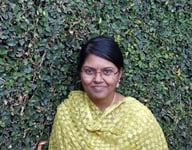














.png)
